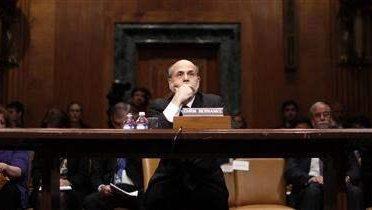Index #11: Last Five Quarters
Anxiety about a double-dip recession has dissipated with the arrival of better economic indicators, but the economy’s overall weakness – and what to do about it – is likely to dominate the news this week with the release of President Obama’s budget proposal, just as it monopolized his State of the Union address and the 19 Republican presidential debates. In the 11th “How We’re Doing Index,” a team of scholars at the Brookings Institution looks at the past five quarters to chart the recent improvements – and determine the likelihood of policy responses ahead of the election. A key factor in November is going to be whether voters focus on the end result of high unemployment and large budget deficits, and how they evaluate the competing theories of why the economy has not done well. But for at least the next few months, non-political actors – particularly the Fed – will be the primary sources of changes in economic policy. Continue reading below chart »
Related Materials:
Past How We’re Doing indexes »
In the fourth quarter, real gross domestic product expanded at its fastest rate since mid-2010, and employment conditions strengthened. Consumer spending increased at a solid clip and the housing sector showed some faint signs of life, with a decrease in the glut of houses that are keeping prices down. Builder confidence rose and climbed further in more recent weeks to its highest level since June 2007, well before the recession began.
Notwithstanding these improvements, the unemployment rate has stayed above 8 percent for three years. Long-term unemployment has decreased but remains at a near-historic high. There are dangers beyond the hardships this imposes on those individuals directly affected. Skills erode as workers spend time unemployed, making it harder for them to find new jobs.
Meanwhile, policymakers in Washington have limited options to support the economy. Between the political gridlock and the coming elections, it is very unlikely significant legislation will be passed before November. Accordingly, the administration has focused on executive action, especially regarding housing. Last fall Obama officials announced a ramped-up effort to allow more “underwater” borrowers to refinance their mortgages at lower rates. More recently, the administration’s foreclosure prevention program was expanded: Eligibility was broadened and incentive payments to banks that reduce the principal balance on loans to troubled borrowers were increased. Additional tools for foreclosure prevention – such as forgiveness of mortgage debt – are part of a settlement announced Thursday between state and federal officials and the largest U.S. banks involved with servicing mortgages whose borrowers subsequently defaulted.
The Federal Reserve could take steps to further boost demand. Fed leaders indicated in January that they expect to keep the federal funds rate – its traditional policy tool – close to zero until late 2014. Given the Fed’s stated expectation that the unemployment rate will decline only gradually, combined with its expectation that inflation will remain at or below the desired target, the Fed could soon attempt to stimulate the economy through unconventional measures such as further purchases of mortgage-backed securities or Treasury bonds. This policy is designed to ease financial conditions in ways that stimulate investment, exports and consumer spending.
But these complicated issues barely register in the dynamic of the 2012 election. In the Republican primaries, a surprising debate has emerged about the merits of capitalism – a narrative that temporarily eclipsed the discussion of whether President Obama’s economic policies have made the economy better or worse. Given the volatility of the Republican nominating process so far, several political surprises are likely along the road to Election Day.
See also:
» State of Metropolitan America—portraying the demographic and social trends that shape our nation’s metropolitan areas
» GovWatch—tracking the progress and performance of our institutions in economic recovery
» MetroMonitor—a barometer of the health of America’s 100 largest metropolitan economies
Sources:
GDP growth:
U.S. Bureau of Economic Analysis
Unemployment rate:
U.S. Bureau of Labor Statistics
Percent unemployed for more than 26 weeks:
U.S. Bureau of Labor Statistics
Disposable personal income:
U.S. Bureau of Economic Analysis
Consumer inflation rate:
U.S. Bureau of Labor Statistics
Dow Jones Industrial Average:
Yahoo! Finance
Consumer sentiment:
Reuters/University of Michigan survey of consumers
Home price index:
CoreLogic
Builder confidence index:
National Association of Home Builders
HAMP modifications:
U.S. Treasury Department
Consumer spending:
U.S. Bureau of Economic Analysis
Months’ supply of new homes:
U.S. Census Bureau
Interest rate on 30-year fixed mortgage:
Freddie Mac
Metro area employment rates:
U.S. Bureau of Labor Statistics
Metro area home price growth:
Case-Shiller Index
U.S. combat fatalities, Iraq and Afghanistan:
icasualties.org
Approval ratings of president and Congress:
Gallup
Percent of Americans “satisfied with the way things are”:
Gallup







